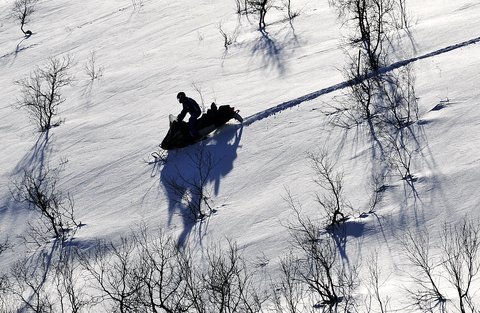Whether out on an ATV day trip, a weeklong snowmobile trip or some other winter excursion that takes you away from town, it is crucial to prepare for the worst in winter conditions.
Water and plenty of layers of winter gear are necessary even if you’re lucky and only stuck in a temporary rut in the cold. When more proactive measures must be taken, snowshoes will help to cover ground, and a shovel can serve multiple purposes including making a temporary shelter and digging a snowmobile or ATV out of a jam.
On the more serious end of emergencies, you’ll want all the necessary items to hunker down for a night in the cold. A group day trip that hugs the edges of some sort of civilization are the safest bet because someone can always go for help within a reasonable distance (with the help of a compass or GPS).
For those who want a truly remote experience, travelling across true back country expanses can mean no help for miles around. On the most adventurous side of trips, you’ll already be setting up camp in the cold, so you’ll have all the necessary gear, but even if you’re just crossing long stretches between hotels and lodging, you should carry foul weather tents and sleeping bags. Energy bars, peanut butter and trail mix are among the best foods to keep our body producing heat.
A waterproof lighter and tinder will help to get a fire going when things are snowy and wet. Waterproof matches work fine as well, but the lighter will outlive that book of matches and typically provide a stronger light. Warmth is the important factor, but the fire will also help to give your position to rescuers if necessary. Saws and knives are helpful for everything from cutting tree branches to preparing wild caught food.
After considering the essentials to survive a night in the cold, you should gather the proper items to suit the actual emergency. First and foremost is a first aid kit. If someone suffers an accident or an unrelated personal health emergency, they will at least be temporarily unable to cover ground. Keeping their vitals until help arrives is literally a life or death necessity.
When mechanical failures leave you trapped, working on the problem is your primary way out of the situation and sending someone for help is your backup. Bring the toolkit that came with your snowmobile or ATV, and if possible bring a ratchet and socket set. A flashlight will be necessary at night (or ideally a headlamp for when you’re performing two-handed fixes in the dark). A tire repair kit will allow you to address the most common of problems on an ATV, while a snowmobile may need an extra drive belt. Spark plugs are small enough to throw into your kit without adding unnecessary space or weight.
Depending on your location, there are some items that are geographically specific. Among them are avalanche beacon to give your position in case you are buried and a probe to gauge snow depth and find what’s underneath. A whistle can help others find you as well, while a signal mirror gives you the ability to use natural light to catch rescuers attention.
As we so often hear wiser minds tell us, a survival skillset is perhaps the most important thing to bring along on a remote trip. Knowing what to use and how to use it ahead of time will save the potentially life threatening situation of trying to learn survival on the fly. Basic mechanic work, fire starting, map reading, fishing/trapping and shelter building know-how will get you far when your luck takes a turn for the worse.
Photo credit: Dreamstime








